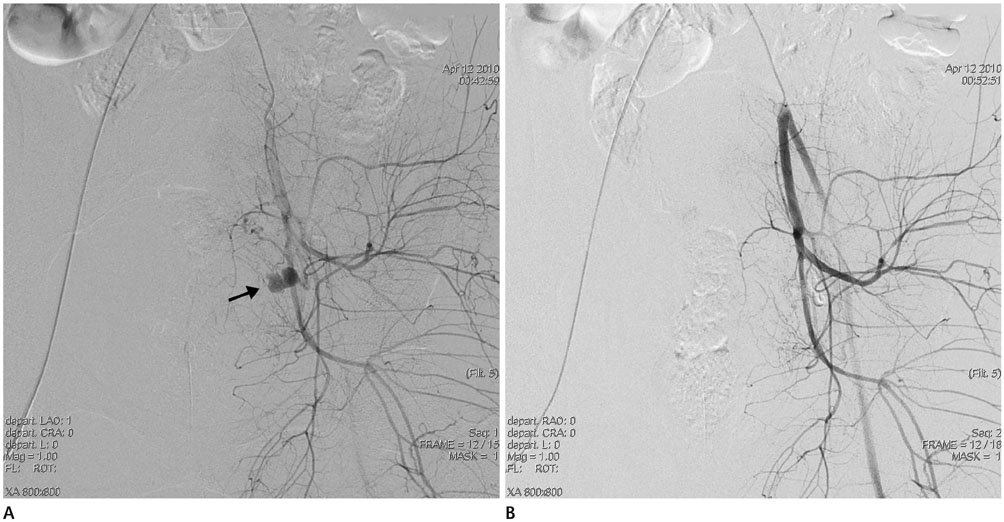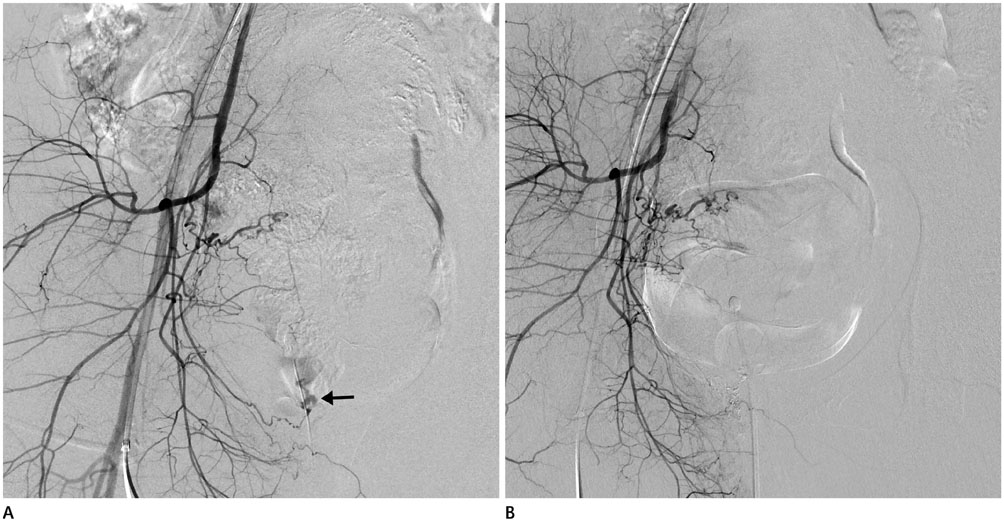J Korean Soc Radiol.
2018 Dec;79(6):315-322. 10.3348/jksr.2018.79.6.315.
Clinical and Angiographic Features of Secondary Postpartum Hemorrhage and the Outcomes of Transcatheter Arterial Embolization
- Affiliations
-
- 1Department of Radiology, Daegu Catholic University Medical Center, Catholic University of Daegu College of Medicine, Daegu, Korea. urkang@cu.ac.kr
- 2Department of Radiology, Dongsan Medical Center, Keimyung University School of Medicine, Daegu, Korea.
- KMID: 2427379
- DOI: http://doi.org/10.3348/jksr.2018.79.6.315
Abstract
- PURPOSE
To analyze the clinical and angiographic features with outcome of transcatheter arterial embolization in patients with secondary postpartum hemorrhage.
MATERIALS AND METHODS
Clinical details and angiographic features with assessment of arterial embolization were reviewed in total 38 patients underwent arterial embolization at single tertiary referral center.
RESULTS
Twenty patients (53%) had Cesarean section. The major causes of bleeding were iatrogenic vascular injury, and retained placenta (55%). The patterns of vaginal bleeding were recorded as intermittent (50%), or as persistent (50%). Seven patients (18%) were hemodynamically unstable at presentation. Positive angiographic findings appeared in eighteen patients (47.3%). The frequency of pseudoaneurysm was statistically high in the Cesarean section (p < 0.001). The used embolic agents except gelfoam were N-butyl cyanoacrylate (n = 7), and microcoil (n = 7). Unilateral selective embolization (26.3%) was shown effective in superselective embolization of bleeding focus. Technical and clinical success rate were 100% and 97.4%, respectively with no complication. Sixteen resumed regular menstruation, and one pregnancy were observed in patients with available follow-up of over 6 months.
CONCLUSION
Considerable rate of hemodynamically unstable patients was observed with high rate of positive angiography findings. Given high successful rate and few complications, early angiographic assessment with embolization should be considered.
MeSH Terms
-
Aneurysm, False
Angiography
Cesarean Section
Cyanoacrylates
Embolization, Therapeutic
Female
Follow-Up Studies
Gelatin Sponge, Absorbable
Hemorrhage
Humans
Menstruation
Placenta, Retained
Postpartum Hemorrhage*
Postpartum Period*
Pregnancy
Tertiary Care Centers
Uterine Hemorrhage
Vascular System Injuries
Cyanoacrylates
Figure
Reference
-
1. Gilbert L, Porter W, Brown VA. Postpartum haemorrhage-a continuing problem. Br J Obstet Gynaecol. 1987; 94:67–71.
Article2. Vegas G, Illesca T, Muñoz M, Pérez-Piñar A. Selective pelvic arterial embolizaion in the management of obstetric hemorrhage. Eur J Obstet Gynecol Reprod Biol. 2006; 127:68–72.3. Pelage JP, Soyer P, Repiquet D, Herbreteau D, Le Dref O, Houdart E, et al. Secondary postpartum hemorrhage: treatment with selective arterial embolization. Radiology. 1999; 212:385–389.
Article4. Hoveyda F, Mackenzie IZ. Secondary postpartum hemorrahge: incidence, morbidity and current management. BJOG. 2001; 108:927–930.5. Ahn EJ, Kim YH, Kim SH, Choi JS, Park JC, Kwon SH, et al. Intractable postpartum bleeding: a comparison of the retrospective analysis of angiographic findings and transcatheter arterial embolization according to delivery pattern. J Korean Radiol Soc. 2008; 59:373–379.
Article6. An EJ, Kim YH, Kwon BR, Kim SH. Transcatheter arterial embolization for postpartum hemorrhage with disseminated intravascular coagulation: outcome assessment. J Korean Soc Radiol. 2011; 65:547–553.
Article7. Gonsalves M, Belli A. The role of interventional radiology in obstetric hemorrhage. Cardiovasc Intervent Radiol. 2010; 33:887–895.
Article8. Lee WH, Yang SB, Goo DE, Kim YJ, Lee JM, Kang CH, et al. Uterine artery embolization: the interventional treatment of female genital diseases. J Korean Soc Radiol. 2017; 76:1–9.
Article9. Park HS, Shin JH, Yoon HK, Kim JH, Gwon DI, Ko GY, et al. Transcatheter arterial embolization for secondary postpartum hemorrhage: outcome in 52 patients at a single tertiary referral center. J Vasc Interv Radiol. 2014; 25:1751–1757.
Article10. Brown BJ, Heaston DK, Poulson AM, Gabert HA, Mineau DE, Miller FJ Jr. Uncontrollable postpartum bleeding: a new approach to hemostasis through angiographic arterial embolization. Obstet Gynecol. 1979; 54:361–365.11. Pelage JP, Le Dref O, Mateo J, Soyer P, Jacob D, Kardache M, et al. Life-threatening primary postpartum hemorrhage: treatment with emergency selective arterial embolization. Radiology. 1998; 208:359–362.
Article12. Greenwood LH, Glickman MG, Schwartz PE, Morse SS, Denny DF. Obstetric and nonmalignant gynecologic bleeding: treatment with angiographic embolization. Radiology. 1987; 164:155–159.
Article13. Deux JF, Bazot M, Le Blanche AF, Tassart M, Khalil A, Berkane N, et al. Is selective embolization of uterine arteries a safe alternative to hysterectomy in patients with postpartum hemorrhage? AJR Am J Roentgenol. 2001; 177:145–149.
Article14. Shim JY, Yoon HK, Won HS, Kim SK, Lee PR, Kim A. Angiographic embolization for obstetrical hemorrhage: effectiveness and follow-up outcome of fertility. Acta Obstet Gynecol Scand. 2006; 85:815–820.
Article15. Lee SY, Ko GY, Song HY, Gwon DI, Sung KB, Yoon HK. Postpartum bleeding: efficacy of endovascular management. J Korean Radiol Soc. 2003; 48:459–465.
Article16. King PA, Duthie SJ, Dong ZG, Ma HK. Secondary post-partum haemorrhage. Aust N Z J Obstet Gynaecol. 1989; 29:394–398.
Article17. Kwon JH, Kim GS. Obstetric iatrogenic arterial injuries of the uterus: diagnosis with US and treatment with transcatheter arterial embolization. Radiographics. 2002; 22:35–46.
Article18. Maleux G, Timmerman D, Heye S, Wilms G. Acquired uterine vascular malformations: radiological and clinical outcome after transcatheter embolotherapy. Eur Radiol. 2006; 16:299–306.
Article19. Iraha Y, Okada M, Toguchi M, Azama K, Mekaru K, Kinjo T, et al. Multimodality imaging in secondary postpartum or postabortion hemorrhage: retained products of conception and related conditions. Jpn J Radiol. 2018; 36:12–22.
Article20. Lee NK, Kim S, Kim CW, Lee JW, Jeon UB, Suh DS. Identification of bleeding sites in patients with postpartum hemorrhage: MDCT compared with aniography. AJR Am J Roentgenol. 2010; 194:383–390.21. Yoon DJ, Jones M, Taani JA, Buhimschi C, Dowell JD. A systemic review of acquired uterine arteriovenous malformations: pathophysiology, diagnosis, and transcatheter treatment. AJP Rep. 2015; 6:e6–e14.
- Full Text Links
- Actions
-
Cited
- CITED
-
- Close
- Share
- Similar articles
-
- Analysis of failed arterial embolization for postpartum hemorrhage
- Recent Update of Embolization of Postpartum Hemorrhage
- Outcomes and complications of embolization for gastrointestinal bleeding
- Transcatheter Arterial Embolization for Postpartum Hemorrhage with Disseminated Intravascular Coagulation: Outcome Assessment
- Intractable Postpartum Bleeding: A Comparison of the Retrospective Analysis of Angiographic Findings and Transcatheter Arterial Embolization According to Delivery Pattern



